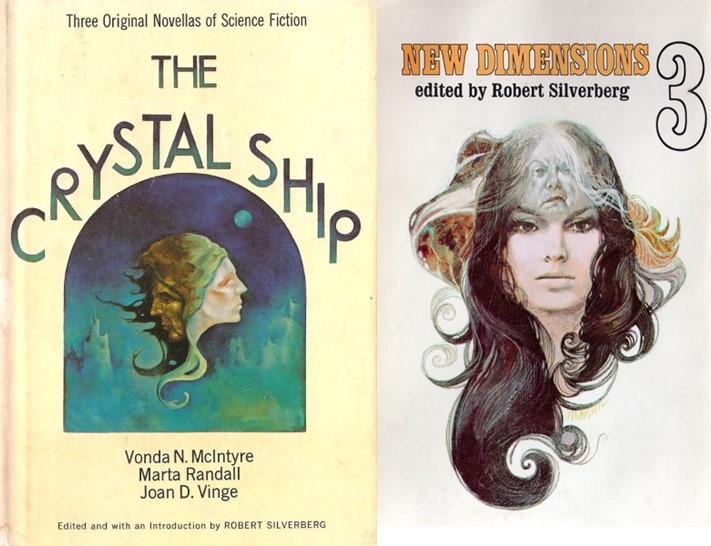Tor Doubles #7: James Tiptree Jr.’s The Girl Who Was Plugged In and Vonda N. McIntyre’s Screwtop

Cover for The Girl Who Was Plugged In by Peter Gudynas
The seventh official volume of the Tor Doubles series offers two stories by women. Although the previous volume offered an excerpt from Gwyneth Jones’ novel Divine Endurance is addition to the selections from Barry B. Longyear and John Kessel, this is the first time women have provided the headlining stories in the series. James Tiptree, Jr.’s The Girl Who Was Plugged In and Vonda McIntyre’s Screwtop, both stories about women whose freedom was curtailed, are collected in this volume. As with the previous novel, this volume also includes an excerpt, in this case a three chapter piece from Ellen Kushner’s Swordspoint.
The Girl Who Was Plugged In was originally published in New Dimensions 3, edited by Robert Silverberg and published by Nelson Doubleday in October, 1973. It was nominated for the Hugo Award and the Nebula Award, winning the former.
James Tiptree, Jr. was a pseudonym for Alice B. Sheldon. Although known to be a pseudonym, it was long assumed that Tiptree was male, and Robert Silverberg, who edited this story before Tiptree’s real identity became known, famously declared “[i]t has been suggested that Tiptree is female, a theory that I find absurd, for there is to me something ineluctably masculine about Tiptree’s writing. The truth of Tiptree’s identity was revealed in 1977. The Girl Who Was Plugged In is the first of three Tiptree stories to be published in the Tor Doubles series.
Reading The Girl Who Was Plugged In in 2025, offers a very different experience from reading it when it was initially published in 1973 or reprinted as part of the Tor Double series in 1989. Although it seems clear that there was a satiric element in this when it was initially published, this it is one of those rare pieces of science fiction which looks prophetic in retrospect. The situation Tiptree described has come, in part, to pass.
Set at an indeterminate point in the future, Tiptree postulates a world in which advertising is illegal. Her story focuses on a young woman named P. Burke, who suffers from pituitary dystrophy, a disease which leaves her disfigured and, as Tiptree makes sure the reader understands, seem like a monster. Following a failed suicide attempt, Burke is placed into essentially a VR chamber and hooked up so she can manipulate a remote body, which becomes known as Delphi.
Delphi is designed to be an attractive woman and work as what we would now call an influencer. Her sole purpose is to be seen, make headlines, and have people wondering what clothing she’s wearing, what products she’s using, and where they might be able to purchase them.
Tiptree’s story is narrated by an unidentified voice who describes the way the world treats Delphi and her adventures mixed with the way the scientists who care for an manipulate P. Burke’s body and inputs. The narrative choice puts a distance between the reader and the characters, which serves to reinforce the isolation P. Burke is in and the faux reality through which Delphi moves, even as she finds herself in a relationship with playboy Paul Isham, who completely misunderstands the situation. As Isham falls in love with the Delphi he perceives, P. Burke, in her isolation chamber, is unable to separate the reality of her situation with the idea that Paul really sees and loves her and she falls in love with him.
Isham realizes something is wrong about the situation and he manages to figure out where the lab P. Burke is being held is located. Despite his failure to comprehend Delphi’s true nature, he attempts to rescue her from the clutches of the scientists who are holding her, resulting in a less than happy ending for nearly all of the story’s characters.
The Girl Who Was Plugged In offers a world of influencers and controllers. Delphi may be the influencer the world sees, but her content is provided by P. Burke, who remains hidden from Delphi’s adoring fans. As the story progresses, the language used to describe P. Burke becomes more and more harsh, removing layer after layer of her humanity. In the end, it is neither the consumer, the influencer, or the reality behind the influencer that benefits from the situation, but rather the powers the set up the situation, making The Girl Who Was Plugged In a cautionary tale for a world that didn’t exist when the story was originally written and published.

New Dimensions cover by Dennis Anderson
Screwtop was originally published in the anthology The Crystal Ship, edited by Robert Silverberg and published by Thomas Nelson in September, 1976.
Kylis is a spaceport rat, essentially a professional interstellar stowaway. A visit to the planet Redsun, however, ended her traveling days as she has been arrested and sentenced to penal labor at the Screwtop prison camp. Kylis strikes up a friendship, and eventually forms a family, with two other prisoners, Gryf and Jason, both of whom appear to be natives of Redsun.
Gryf is the product of tetraparents, a genetically crafted person who has the DNA of four separate parents. Meant to be highly intelligent, a glitch in the combination of DNA meant that he came out with strange coloring that set him apart from people. Gryf was also aware of Jason’s identity as a major philosophical author, which he shared with Kylis, although asking her not to let Jason know that they knew.
Focusing on Kylis, McIntyre depicts the horrors of the work camp. The throuple forced to the schedule set for them by the powers that be, represented in the camp by a guard called the Lizard. When their time allows it, they can seek solace in each other and form a family for themselves. This time almost makes their shifts working bearable.
The work is difficult. Screwtop is located on Redsun’s southern continent, which appears to be an uninhabited wilderness. Their job is to mine for geothermal energy, which is used to power the more massive and populated northern continent, where Gryf, Jason, and the majority of the prisoners are from. Naturally humid and hot, the mining process is even hotter and dangerous if precautions aren’t taken.
Once McIntyre establishes her setting and the characters’ relationships to each other, she is able to more fully explore the dynamics of the prison. Kylis reaches out to another woman prisoner, Miria, in a manner which may cause undue attention to be brought to her group. The Lizard approaches Kylis to extort not only sexual favors, but the implicit desire to have a child by her. The strength and purpose being in a supportive relationship with Gryf and Jason is demonstrated to have negative implications and it can be used against them.
In many ways, Screwtop feels as if it could be a prison story set anywhere, without the need for the science fictional elements. Kylis could merely be a runaway, Jason a dissident, and the workforce a regular mine. However, Gryf’s situation as the product of tetraparents becomes an important plot point. Although not fully explored, partly due to Kylis’s role as a narrator, his science fictional origin and upbringing, and his rebellion against it, focuses the story in him in the later pages as it becomes clear that his parents know of his whereabouts and may have the wherewithal to affect his release. More importantly, his way of dealing with the reality in which he finds himself is based on his unique situation.
Both Screwtop and The Girl Who Plugged In focus on individuals who are trapped by other people, Kylis has more agency that P. Burke and the relationship Kylis has with Gryf and Jason, although not based entirely on reality of knowledge of the others, is a more authentic relationship than the one between Isham and Delphi. Similarly, McIntyre does not place a distance between the story and the reader by the expedient of having her narrator a participant rather than an observer.
The cover for Screwtop was painted by Maren. The cover for The Girl Who Was Plugged In was painted by Peter Gudynas. At only 136 pages, this volume is the shortest in the Tor Double series.
 Steven H Silver is a twenty-one-time Hugo Award nominee and was the publisher of the Hugo-nominated fanzine Argentus as well as the editor and publisher of ISFiC Press for eight years. He has also edited books for DAW, NESFA Press, and ZNB. His most recent anthology is Alternate Peace and his novel After Hastings was published in 2020. Steven has chaired the first Midwest Construction, Windycon three times, and the SFWA Nebula Conference numerous times. He was programming chair for Chicon 2000 and Vice Chair of Chicon 7.
Steven H Silver is a twenty-one-time Hugo Award nominee and was the publisher of the Hugo-nominated fanzine Argentus as well as the editor and publisher of ISFiC Press for eight years. He has also edited books for DAW, NESFA Press, and ZNB. His most recent anthology is Alternate Peace and his novel After Hastings was published in 2020. Steven has chaired the first Midwest Construction, Windycon three times, and the SFWA Nebula Conference numerous times. He was programming chair for Chicon 2000 and Vice Chair of Chicon 7.
I think the most interesting thing about “The Girl Who Was Plugged In” (aside from being an absolute killer of a story) is that it’s the only “A-Level” Tiptree story that I can think of that’s told in the slangy, wise-cracking, breakneck narrative voice that Sheldon used for so many of her earlier stories but had abandoned by the time she was doing her greatest work. I can’t think of another story of hers where the gap between the mode and the message is so wide, and “The Girl Who Was Plugged in” is all the more effective because of that ironic contrast.
I have so many other things to read, but you’ve made me want to drop them all and reread some Tiptree!
Sheldon has been a favorite for years, and I clearly need to re-read this piece. “The Screwfly Solution” is among my all-time favorite pieces of writing, any genre, any style, any period.
I recently reread quite a bit of Tiptree’s work for the first in several decades – including “The Girl Who Was Plugged In”. Having long since forgotten most of the story (other than than the basic idea of a damaged person remotely controlling a synthetic body), I was flabbergasted by its portrayal of influencer culture. I found myself thinking “This is – now!”; the very rare experience of reading an old SF story and finding that it had indeed correctly predicted the future.